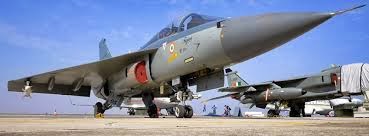The Kalaikunda airbase today witnessed three MiG-27 aircraft perform the Trishul Break Manoeuvre as a salute to the MiG-21 type 77 aircraft that was towed out and into the Hangar for the last time.
The Kalaikunda based Operational Conversion Unit (OCU) bid a final farewell to its oldest workhorse.
Air Chief Marshal NAK Browne, Chief of the Air Staff who was present at the occasion of phasing out MiG 21, Type -77 in his address said, “Today’s event marks a watershed moment in IAF’s history as we reach the end of nearly five decades of remarkable operational service rendered by this iconic fighter.
The induction of first batch of six MiG 21s way back in Mar-Apr 1963 heralded the arrival of IAF in the ‘Supersonic era’.
Its unprecedented combat versatility afforded the IAF great amount of operational flexibility. Over the years, this delta wing marvel slowly evolved into the combat backbone of the IAF and close to 1000 fighters (which include all variants) have served in the IAF till date. In 1980-90s the MiG-21s constituted nearly 60% of our combat fleet strength.
It is no wonder therefore that five generations of our combat pilots including myself, who have ‘cut teeth’ on this veritable fighter swear by its unmatched combat prowess.
As a matter of fact around 80% of the presently serving fighter aircrew in the IAF have flown the T-77 aircraft and 90% have flown one of the MiG variants at some time or the other in their flying career.
The T-77 fleet has been flying on an average around 9000 hours per year. Today, while we operate the Su 30s and are looking forward to inducting the Rafale MMRCA, MiG-21 fighters (all variants) continue to proudly contribute to the IAF’s operational strength.
I salute your spirit of service and of countless other air warriors who brave daily challenges of operating and maintaining this fighter in the highest operational conditions in our various stations across the Air Force.
The T-77 may have flown its last sortie today, but its imprint on the ‘Operational DNA’ of the IAF will continue for a long time. Gradually the other variants of the MiG-21 would also retire from service with Bison continuing for more than a decade or so.
We are indeed proud of the five decades of professional association with MiG-21 and are grateful for its invaluable contribution to the IAF over the years.
I am sure that from this day onwards the MiG-21 T-77 will proudly go down in history as one of the finest combat aircraft which has served the IAF over the years.
On behalf of all the men and women of the IAF, I salute this veritable fighter and the contributions of all those who made it possible for our young fighter pilots to touch the sky with glory. Jai Hind!”
The Kalaikunda based Operational Conversion Unit (OCU) bid a final farewell to its oldest workhorse.
Air Chief Marshal NAK Browne, Chief of the Air Staff who was present at the occasion of phasing out MiG 21, Type -77 in his address said, “Today’s event marks a watershed moment in IAF’s history as we reach the end of nearly five decades of remarkable operational service rendered by this iconic fighter.
The induction of first batch of six MiG 21s way back in Mar-Apr 1963 heralded the arrival of IAF in the ‘Supersonic era’.
Its unprecedented combat versatility afforded the IAF great amount of operational flexibility. Over the years, this delta wing marvel slowly evolved into the combat backbone of the IAF and close to 1000 fighters (which include all variants) have served in the IAF till date. In 1980-90s the MiG-21s constituted nearly 60% of our combat fleet strength.
It is no wonder therefore that five generations of our combat pilots including myself, who have ‘cut teeth’ on this veritable fighter swear by its unmatched combat prowess.
As a matter of fact around 80% of the presently serving fighter aircrew in the IAF have flown the T-77 aircraft and 90% have flown one of the MiG variants at some time or the other in their flying career.
The T-77 fleet has been flying on an average around 9000 hours per year. Today, while we operate the Su 30s and are looking forward to inducting the Rafale MMRCA, MiG-21 fighters (all variants) continue to proudly contribute to the IAF’s operational strength.
I salute your spirit of service and of countless other air warriors who brave daily challenges of operating and maintaining this fighter in the highest operational conditions in our various stations across the Air Force.
The T-77 may have flown its last sortie today, but its imprint on the ‘Operational DNA’ of the IAF will continue for a long time. Gradually the other variants of the MiG-21 would also retire from service with Bison continuing for more than a decade or so.
We are indeed proud of the five decades of professional association with MiG-21 and are grateful for its invaluable contribution to the IAF over the years.
I am sure that from this day onwards the MiG-21 T-77 will proudly go down in history as one of the finest combat aircraft which has served the IAF over the years.
On behalf of all the men and women of the IAF, I salute this veritable fighter and the contributions of all those who made it possible for our young fighter pilots to touch the sky with glory. Jai Hind!”
